Texts 01
What We Talk About When We Talk About Death
By Carolina Iacucci
The Eternal Transit Space
By Domoina Ratsara
A Fun Ride
By Flavia Dima
How to Stage Colonialism
By Iván Zgaib
Carry-ons: Time and Reminiscences in Park Kiyong’s OLD LOVE
By Jesse Cummings
The Unintentional Allegory of Our Times
By Kennith Rosario
Forced Out of the Box
By Lilla Puskas
Because There’s No Silver Lining to Poverty:
The Conceptual Flaws of WHAT COMES AROUND
By Yasmine Zohdi
What We Talk About When We Talk About Death
By Carolina Iacucci
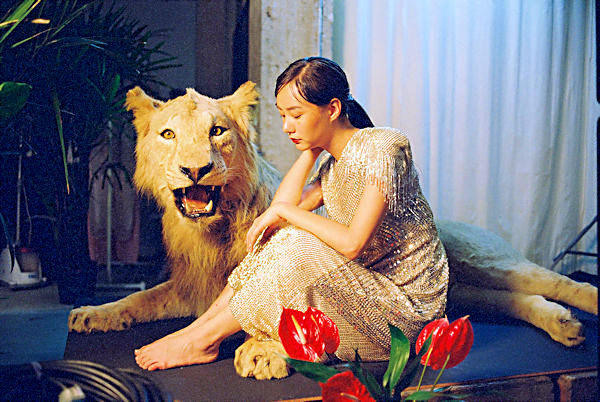 DIE TOMORROW by Thai filmmaker Nawapol Thamrongrattanarit combines essayistic inserts and episodes of ordinary life in order to both elegiacally and understatedly explore the unpredictability of death. The result is a hypnotic celebration of the magical randomness of being alive.
DIE TOMORROW by Thai filmmaker Nawapol Thamrongrattanarit combines essayistic inserts and episodes of ordinary life in order to both elegiacally and understatedly explore the unpredictability of death. The result is a hypnotic celebration of the magical randomness of being alive.
Eclectic director Nawapol Thamrongrattanarit is interested in filming people frivolously chatting about everyday topics: four flatmates read their horoscope and share their wishes for a future they take for granted; two siblings reunited after a long separation hang their clothes out to dry on a terrace overlooking Bangkok; a young woman waiting for a heart transplant clips her boyfriend’s nails while haunted by the phantom of her precarious survival. DIE TOMORROW is a thought-provoking cinematic experience gracefully confusing fictional and non-fictional levels by fragmenting its philosophical discourse on death: it is built as a kaleidoscopic essay mingling fictitious sketches, documentary interviews, news reports, and musical tracks in order to set up a lyrical encyclopedia about the most unspeakable social taboos and our deepest fear.
Within its deliberate syncretism and multifaceted dramatic quality, DIE TOMORROW epitomises the haphazardness of biological life by confronting the two opposite terms of its course: when asked about his idea of death, a kid acknowledges he googled it and actually realised that it somehow deals with disappearance; a half-deaf hundred-year-old man is shocked about his being alive for so long and energetically states that death is not the point, while life is. This is also the point of this anthological movie, which apparently chases the truth about death, but actually thinks about life.
Indeed, while following the fleeting flow of his characters’ thoughts, images, and talks, the director progressively discloses the mystery of individual fate and, rather than equate it to the ultimate penalty of vacuity and nothingness, he sees in it an opportunity to understand, accept, and discover a sort of magical levity. Thus, lightness is the landing place of this film seemingly focused on a depressing matter and eventually turning into a luminous contemplation of the beauty of nonchalantly living a life without purpose. As one of the girls says at a certain point in the first part of the movie, life is not fun with spoilers, and probably the only way to give it meaning is to not look for it at all.
The Eternal Transit Space
By Domoina Ratsara
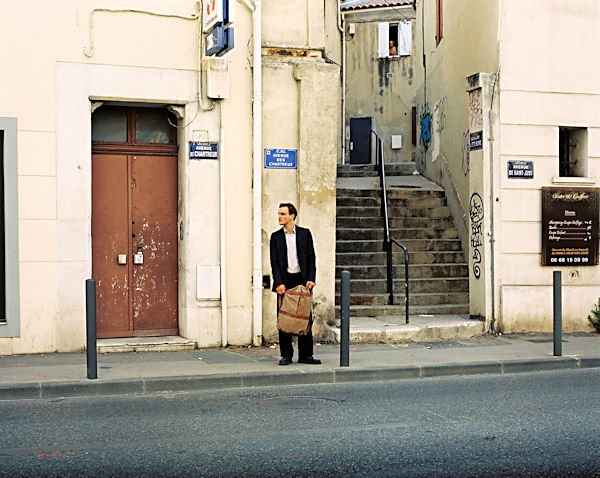 Christian Petzold’s new feature, TRANSIT, shown in competition at the 68th Berlinale, is a truly peculiar work. Although it is based on a book first released in 1944 – Anna Seghers’ homonymous novel –narrated by a young German man stuck in Marseille after escaping a German concentration camp in 1937, the film is structured and shot in a contemporary scenario.
Christian Petzold’s new feature, TRANSIT, shown in competition at the 68th Berlinale, is a truly peculiar work. Although it is based on a book first released in 1944 – Anna Seghers’ homonymous novel –narrated by a young German man stuck in Marseille after escaping a German concentration camp in 1937, the film is structured and shot in a contemporary scenario.
In the middle of the controversial debate on European engagement with the fates of refugees, Petzold’s device explores the idea of temporality and plays with different historical contexts – as if he is trying to build an “eternal transit space”.
When the director sets his characters in the contemporary world, the linear time conception is completely blown away. This temporal confusion sheds light on migration issues that seem to have little or no changes over the years. By confronting the past with the present, Petzold proposes a multilayered approach and explores this composite transit space.
The story follows Georg as he is commissioned by a friend to deliver two letters to a writer named Weidel – only to find out that he has committed suicide. Georg takes all his documents (passport, visa and a manuscript) and escapes to Marseille, where he meets Marie, the mysterious writer’s wife. It is obvious that the novel carries out some of Petzold’s favorite themes, especially in the refugees’ identity crisis (as Georg assumes the writer’s identity) and the ghost-like existence of Marie.
Besides this temporal device, Petzold uses voice-over narration taken from the book that also helps to build the strange mood that permeates the movie – but it also adds some extra confusion to the viewer’s experience.
Among so many documentary and fiction films addressing the contemporary migration issues, TRANSIT definitely calls for a different social, political and formal approach to the issue of refugees and asylum-seekers.
A Fun Ride
By Flavia Dima
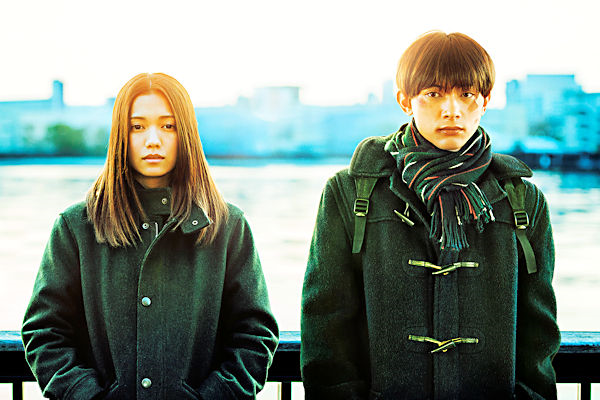 Japan, 1994 – existential boredom plagues the lives of six angsty teenagers, whose own brand of “mal de siècle” implies bullying, bulimia or borderline psychopathy. Isao Yukisada’s latest feature is a live-action adaptation of Kyoko Ozaki’s eponymous manga, that is faithful to the elliptical nature of comic book narratives. RIVER’S EDGE, showing in Berlinale Panorama, is a far-reaching portrait of Japan’s disaffected youth: each of Yukisada’s protagonists has something disturbing at the core of their identities, while offering a unique spin on classical anime archetypes.
Japan, 1994 – existential boredom plagues the lives of six angsty teenagers, whose own brand of “mal de siècle” implies bullying, bulimia or borderline psychopathy. Isao Yukisada’s latest feature is a live-action adaptation of Kyoko Ozaki’s eponymous manga, that is faithful to the elliptical nature of comic book narratives. RIVER’S EDGE, showing in Berlinale Panorama, is a far-reaching portrait of Japan’s disaffected youth: each of Yukisada’s protagonists has something disturbing at the core of their identities, while offering a unique spin on classical anime archetypes.
Haruna Wakakusa is a stoic, chain-smoking teenager struggling to choose between Kannonzaki, her bully boyfriend, and his victim, Ichiro Yamada. As Haruna and Ichiro’s friendship deepens, so does she sink deeper into the closeted teen’s innermost secrets and his relationships with Kozue, a bulimic supermodel, and Kanna, Yamada’s disturbingly sweet show-girlfriend.
Yukisada’s intervention lies in a series of faux-interviews with the protagonists (which intercut the plot) where the teenagers open up about their families and intimate fears. But in spite of its morbid tone, RIVER’S EDGE doesn’t shy away from comedic, campy moments – as one foreplay scene hilariously cuts to Kozue eating pizza, one ends up pondering the many wondrous opportunities of the Kuleshov effect. The film’s elliptical editing is one of its most provocative facets, making the first half-hour a puzzling, dark and disjointed narrative. And it does work towards constructing suspense: some shots are cut in mid-action or the music is sometimes stopped mid-scene, in what is seemingly a cinematographic homage to the sequential nature of comic strips. However, as the plot starts making more and more sense, these devices start to seem somewhat flat and conventional, stripping away much of the mysterious atmosphere that was present in the beginning.
Although it’s no masterpiece, RIVER’S EDGE is a thoroughly captivating offering from this year’s Panorama section which constantly challenges expectations – is it a coming-of-age comedy or a horror movie? Are these kids intrinsically messed up or a product of their social medium? And where are all these seemingly random cuts leading to? It’s up to you to find out and decide, but it’s certainly a fun ride.
How to Stage Colonialism
By Iván Zgaib
 A black woman stares straight into the camera. “I’ve been whitewashed,” she says dramatically. So WE LIVE IN SILENCE: CHAPTERS 1-7 (Berlinale Forum Expanded) opens, and artist and filmmaker Kudzanai Chiurai formulates a critical response to Med Hondo’s 1967 film SOLEIL O. By playing with ironies and contradictions, a theatrical approach to form and acting shapes a precise political perspective. It only takes 36 minutes for Chiurai to make a tenacious statement: colonialism is still present today. Thus, colonial hypocrisy is turned upside down by a series of tableaus: black people are suddenly repeating their colonizer’s actions and discourses. A woman of color even defends African slavery as if she herself had become a slaver.
A black woman stares straight into the camera. “I’ve been whitewashed,” she says dramatically. So WE LIVE IN SILENCE: CHAPTERS 1-7 (Berlinale Forum Expanded) opens, and artist and filmmaker Kudzanai Chiurai formulates a critical response to Med Hondo’s 1967 film SOLEIL O. By playing with ironies and contradictions, a theatrical approach to form and acting shapes a precise political perspective. It only takes 36 minutes for Chiurai to make a tenacious statement: colonialism is still present today. Thus, colonial hypocrisy is turned upside down by a series of tableaus: black people are suddenly repeating their colonizer’s actions and discourses. A woman of color even defends African slavery as if she herself had become a slaver.
But the film’s biggest achievement lies in its capacity to avoid a didactic exposition through dialogue. Quite the opposite, Chiurai’s political point of view takes the shape of pictorial framing. This is especially evident in the long durational still shots, where the image resembles a painting inhabited by moving bodies. This manifestation of the artifice also appears within the characters; their elegant poses, their theatrical speeches and their gazes directed toward the camera reveal a fictionalised universe in creation. The jungle setting is full of plastic vegetation, suggesting that the colonial mindset is not natural, but staged and artificial.
From time to time, WE LIVE IN SILENCE: CHAPTERS 1-7 changes its fixed camera for delicate movements that reframe the visual perspective. It is through this exploration of space that Chiurai contrasts different visions that often seem contradictory. Take the final scene where a group of black women in colonial dress are seated around a large table. As the camera dollies out, the space widens to reveal a modern-day white cop chasing a group of black people dressed in jeans and t-shirts. This camera work allows for the mise-en-scène to play out like a game of confused temporalities. Has colonialism really ended? Chiurai’s contemporary treatment of the historical imaginary erases a clear distinction between past, present and future. By the end, the film rediscovers cinematic language as a device to raise new questions about the imposition of a colonized perspective.
Carry-ons: Time and Reminiscences in Park Kiyong’s OLD LOVE
By Jesse Cummings
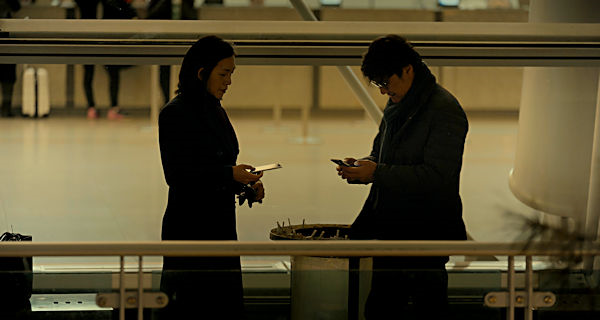 Despite a steady output of features and documentaries, Korean filmmaker Park Kiyong returns to the Berlinale with OLD LOVE, for the first time since CAMEL(S) in 2001, screening once again in Forum. The film opens with a high-angle panorama of travellers at a Korean airport; the mass is largely nondescript until a woman enters the frame and commands our attention. While smoking alone outside the terminal shortly thereafter, she unexpectedly notices – and interpellates – her lover of decades past.
Despite a steady output of features and documentaries, Korean filmmaker Park Kiyong returns to the Berlinale with OLD LOVE, for the first time since CAMEL(S) in 2001, screening once again in Forum. The film opens with a high-angle panorama of travellers at a Korean airport; the mass is largely nondescript until a woman enters the frame and commands our attention. While smoking alone outside the terminal shortly thereafter, she unexpectedly notices – and interpellates – her lover of decades past.
From this point on the film rarely strays from this woman, Yoon-hee (Yoo Jung-ah) and this man, Jung-soo (Kim Tae-hoon). Having moved to the Canadian prairies, where she lives with her son, Yoon-hee returns to Seoul for the winter holidays. Alongside a steadily pallid sky, this holiday provides the background for the film, in which an occasion typically associated with family and celebration is instead filled with uneasy exchanges and bittersweet reminiscences.
All around the pair are often painful reminders of the passage of time: a son’s forthcoming wedding, a daughter’s college matriculation, a mutual friend with a terminal illness, and shared concerns about their parents: Yoon-hee’s is suffering from dementia, while Jung-soo’s is under the supervision of a home nurse. None are shown, but, like the couple’s previous decades apart, they inform all of their present words and gestures. Instead the film is almost exclusively limited to scenes of the two together, or of them navigating the city alone.
Theatre remains a theme that runs through the core of the film, eventually growing to serve as a symbol of what could have been, as we learn of the pair’s long-abandoned plans to live and perform together. Using extended sequences with uninterrupted dialogue, Park creates in OLD LOVE an astonishing sense of cinematic time and place – the brittle winter air feels palpable, while the moments spent in the company of these reunited lovers feel at the same time slow and ever-fleeting. Eventually, in one of the film’s most moving moments, OLD LOVE slows to a near standstill with the two locked in a tight, nocturnal embrace, as decades collapse into an instant.
The Unintentional Allegory of Our Times
By Kennith Rosario
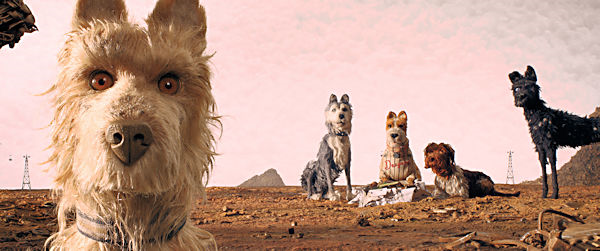 Two years ago, when American filmmaker Wes Anderson started making ISLE OF DOGS (United Kingdon, Germany), he didn’t intend to make an allegorical film on the current times. “I simply wanted to tell a story about dogs on a trash island,” he says at the press conference for the 68th Berlin International Film Festival. From the onset, he wanted to set it in a dystopian future, so he started inventing the politics of an imaginary Japanese society. Set in a cat-dominated city, the mayor demands all dogs to be sent off to a trash island. He claims that all dogs are incurably infected by “snout fever” and must be quarantined. He uses military force to implement this radical decision, and the media to mislead citizens.
Two years ago, when American filmmaker Wes Anderson started making ISLE OF DOGS (United Kingdon, Germany), he didn’t intend to make an allegorical film on the current times. “I simply wanted to tell a story about dogs on a trash island,” he says at the press conference for the 68th Berlin International Film Festival. From the onset, he wanted to set it in a dystopian future, so he started inventing the politics of an imaginary Japanese society. Set in a cat-dominated city, the mayor demands all dogs to be sent off to a trash island. He claims that all dogs are incurably infected by “snout fever” and must be quarantined. He uses military force to implement this radical decision, and the media to mislead citizens.
At a time when Europe faces a refugee crisis and the rise of right-wing xenophobia, and U.S. President Donald Trump is accused of discrediting and manipulating the media, ISLE OF DOGS is a rather appropriate opening film for this year’s Berlinale. In the time that it took to make the film, Anderson says, the world changed so much that he eventually sought inspiration from reality. “So we think this film is right for the moment,” he says.
Beyond the narrative, the visual details and variety of animation techniques in the film speaks volumes of its allegorical nature. From hand-drawn 2D animation for news footage to puppets and dolls for stop-motion, Anderson uses traditional animation techniques to draw the viewer back into the pre-digital era. No part of the film is purely computer-generated imagery, which lends it a sheen of authenticity (with all its rough edges). “With THE GRAND BUDAPEST HOTEL (2014), and before that with MOONRISE KINGDOM (2012), I realised I love models,” he says. “I liked it when models popped up in Alfred Hitchcock’s films.” ISLE OF DOGS is also Anderson’s way of paying homage to other filmmakers, like the classic animation of Hayao Miyazaki (SPIRITED AWAY, 2001) and samurai epics of Akira Kurosawa (RASHOMON 1950), making it part of a larger cinema heritage.
Forced Out of the Box
By Lilla Puskas
 Women’s fear of aging is deeply rooted in mass media representation of elderly female characters. They are often overlooked or tend to appear on screen as passive, unbalanced or struggling with health issues. With his unique and surprisingly mature debut feature, Marcelo Martinessi goes against this harmful tendency and presents a financially ruined bourgeois woman in her fifties, capable of taking her life into her own hands.
Women’s fear of aging is deeply rooted in mass media representation of elderly female characters. They are often overlooked or tend to appear on screen as passive, unbalanced or struggling with health issues. With his unique and surprisingly mature debut feature, Marcelo Martinessi goes against this harmful tendency and presents a financially ruined bourgeois woman in her fifties, capable of taking her life into her own hands.
The heroine of the Berlinale Competition film THE HEIRESSES (LAS HEREDERAS, Paraguay-Uruguay-Germany-Brazil-Norway-France) comes from noble family but slowly loses her privileged position in society. When her partner Chiquita (Margarita Irún) is accused of fraud and imprisoned, Chela (Ana Brum) seems paralysed, but later she starts the first job in her life that brings her challenges and unsettling encounters.
The Paraguayan director-screenwriter focuses on a contemporary universe where men are simply left out of the frame. In a condensed world like this, generational and social issues come more to the forefront. The impoverished Chela starts working as a driver, transporting obnoxious bourgeois women who are older than her. They tend to complain about their maids and spread gossip; their behavior foreshadows what Chela could have become had she not been forced to leave her luxurious life behind. While observing the upper class with sharp criticism, the director portrays lower social classes with empathy.
Luis Armando Artega’s complex and innovative cinematography supports these observations and the dramatic development. Chela’s exclusion from her social class is emphasised by shots that often show her alone, behind a closed door listening to conversations percolating through the wall. Mirrors and frames within frames enable collage-like images where the viewer can observe a tableau of up to eight faces at the same time. The visuals skillfully reflect Chela’s transformation. Initially she is often portrayed from the back. Even before she becomes a driver, the viewer already seems to be watching the nape of her neck from the black seat. Later on, as her rejuvenation unfolds, her face and body get more and more exposed. Some of these images have an erotic quality, implying that her active life has not yet ended. Such a vivid portrayal of Martinessi’s central heroine emancipates a woman facing the constraints of class and age.
Because There’s No Silver Lining to Poverty:
The Conceptual Flaws of WHAT COMES AROUND
By Yasmine Zohdi
 “Egyptians will always dance, no matter how poor or hungry they are,” says one character in Reem Saleh’s WHAT COMES AROUND (Al Gam’iya, Egypt), as she watches two neighborhood girls joyously dance on the street. This sentence, which comes off more than a little contrived, captures the director’s intention throughout the film, and also the underlying problem in its premise: Poverty doesn’t necessarily have to stand in the way of happiness.
“Egyptians will always dance, no matter how poor or hungry they are,” says one character in Reem Saleh’s WHAT COMES AROUND (Al Gam’iya, Egypt), as she watches two neighborhood girls joyously dance on the street. This sentence, which comes off more than a little contrived, captures the director’s intention throughout the film, and also the underlying problem in its premise: Poverty doesn’t necessarily have to stand in the way of happiness.
The 79-minute documentary, which plays in Panorama at this year’s Berlinale, is set in Rod El Farag, one of Cairo’s poorest and most populous residential areas. It follows a group of the neighborhood’s inhabitants as they organise a credit union, or “gami’ya,” whereby each of them contributes an amount of money, and each week one of them gets the aggregated sum, according to who needs it most.
The gami’ya is used as a window that allows us into the lives of five characters that Saleh followed over the course of seven years, as they struggle to make ends meet. They laugh, argue, marry, divorce, give birth and undergo spiritual transformations, but the narrative style is often inconsistent, reaching near-climactic notes in the film’s third act without proper build-up. Saleh attempts to paint a pleasant picture of that community, banding together despite the hardships they face.
Yet the film’s questionable approach stands out when one girl insists to use the money her mother gets from the union on an FGM operation. In one scene, she describes the process in harrowing detail, with a hint of pride, and – even more disturbing – humour. It is shocking how lightly the whole thing is dealt with.
In the Q&A after the film, Saleh gushes at how “beautiful” Rod El Farag is, the cramped slum nestled against the railway where people constantly fight for their basic needs. But there is nothing charming about poverty, and trying to tell a feel-good story within such a setting, stripped of anger and politics, renders WHAT COMES AROUND an impotent work, and an insensitive one at that.
